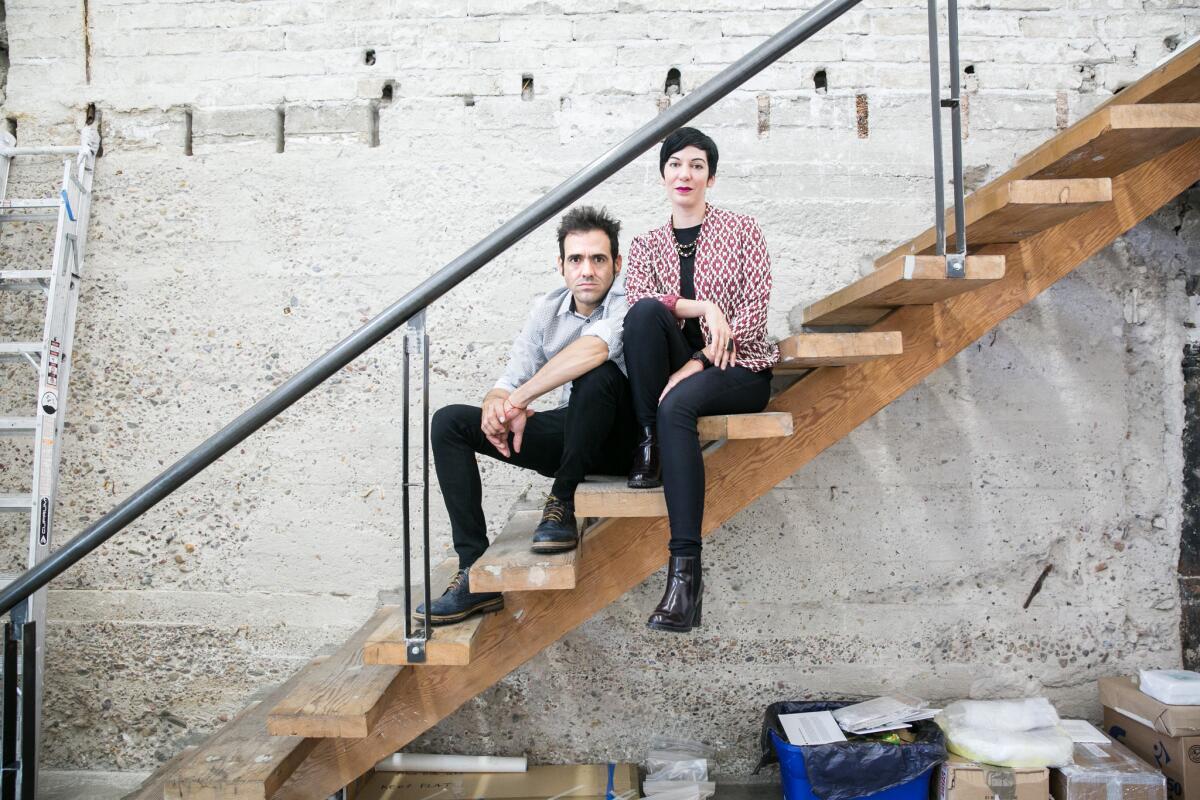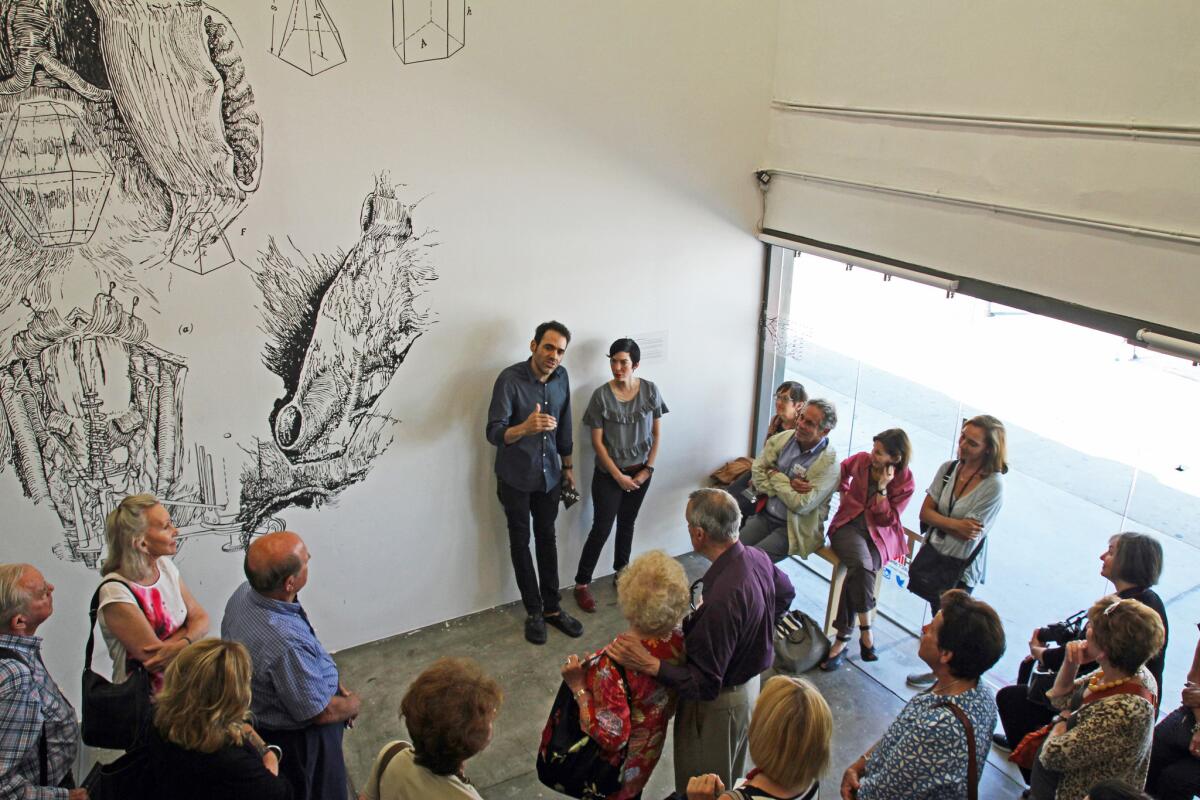The evolution of Avenida Revolución and a gallery called TJ in China

Tijuana artists Daniel Ruanova and Mely Barragán at their art gallery, TJ in China ProjectSpace. For almost three years, the space has served as a hub of international contemporary art in Tijuana.
Reporting from Tijuana â The experience of Tijuana can be summed up by a single thoroughfare: Avenida Revolución â the street named for the Mexican Revolution â which has itself always been a revolution of sorts.
This is where, for decades, tourists to the city have come to eat and drink and dance and possibly find illicit amusements. Itâs where the Caesar Salad was reportedly invented. And itâs where itâs possible to have your picture taken alongside a donkey painted to resemble a zebra.
Which is exactly why Tijuana artists Daniel Ruanova and Mely Barragán wanted to open a gallery there.
âWe used to come down and dance here,â says Ruanova, standing in the middle of Revolución, gesturing toward the black-lighted bars and thumping clubs that still hug bits of the strip.
âWe wanted Revolución,â adds Barragán, âbecause everyone in Tijuana at some point or another has to be on Revolución.â
So in 2013, the pair opened TJ in China ProjectSpace on the southern end of Revolución â or as everyone in Tijuana affectionately calls it: âLa Revu.â
This is a young city without an art market, so the space could really be about experimentation
— Mely Barragán, co-founder of TJ in China ProjectSpace
Barragán and Ruanova were both born and raised in the city and describe themselves as a couple of âborder ratsâ: fully bilingual, as comfortable with the minutiae of Mexican culture as they are with that of the U.S.
They are a couple â a charming one, with the ability to complete each otherâs thoughts. They are also artists: she works in collage and soft sculpture; he as a painter and sculptor. And theyâve both shown their work in museums and galleries throughout Mexico and the United States.
Ruanova, additionally, has had exhibitions and residencies in China, which for a time took the couple to Beijing. In fact, for two years starting in 2011, the couple ran their first TJ in China space there, where they showed a mix of international and Chinese artists.

In 2013, they received a grant to work in Mexico and returned to Tijuana with the idea of opening a space on Revolución. They took over a storefront that had once housed a curio shop and crispy taco stand and transformed it into an artist-run exhibition space.
âThis is a young city without an art market,â says Barragán. âSo the space could really be about experimentation.â
âArtists like it,â she adds, âbecause of the freedom.â

Ruanova and Barragán at their space in June, hosting a group from the Museum of Contemporary Art San Diego.
Since its foundation, TJ in China has become a staple of the contemporary Tijuanaâs contemporary art scene. Group shows on the urban landscape, border politics and labor issues have generated attention from Mexican and American journalists. And over the galleryâs short life, the couple have hosted artist talks and open-call video-art nights as well as a dozen residencies for a wide gamut of international artists.
The goal, say Barragán and Ruanova, has been to create a place of exchange â where Tijuana artists can meet the world and vice versa.
âWhat we try to do,â explains Ruanova, âis bring the best art we can to the people of Revolución.â

If the idea of a buzzy contemporary gallery amid a hub of garish party spots seems unlikely, well, it is.
Just over a decade ago, Tijuanaâs bustling tourist trade would have put rents on Avenida Revolución out of reach to anyone who wasnât selling cheap tequila and crispy things to soak it up with. Which pretty much meant that the strip was off limits to most outlets of high culture.
But Tijuanaâs highly publicized period of cartel violence, which heated up in 2008, put a chill on tourism. The number of homicides has fallen dramatically since then, but tourism nonetheless remains weak â leaving many of the discos, bars and clubs on Revolución permanently shuttered.
This has made portions of this party strip surprisingly affordable. In the early 2000s, during the height of the tourist trade, TJ in Chinaâs 1,000-square-foot space might have rented in the vicinity of $5,000 a month. Barragán and Ruanova, who operate their gallery as a not-for-profit, funded primarily through grants, pay just $500 a month.
To be certain, TJ in China wasnât the first cultural space to land on Revolución. That began in 2010, with the establishment of smaller art galleries and other pop-up spaces in the moribund Pasaje Rodriguez, one of the narrow commercial arcades that extend off Revolución â and this type of development has since extended to Pasaje Gomez nearby.
Both arcades offer a lively mix of fringe art spaces, boutiques and eateries catering to the hipster regimen of craft beer and vegan eats. (KCETâs Artbound has a good story on their development.)
Collectively, the presence of all of these cultural spaces has changed aspects of Revolución rakish character. In the Pasaje Rodriguez, you can sip beer from Mamut, a local brewery, while taking in a performance.
Next door to TJ in China, you can now find Doratto, a hip boutique featuring fashion by Tijuana designers (as well as an old truck from which baristas dispense espresso).
âAnd nearby they will be building an art cinema,â says Ruanova, pointing toward an space across the street. âBefore, that would have been the kind of place where tourists would have come to drink beer and party.â
If thereâs something that sets in TJ in China apart itâs their international ambitions â something that is fed by their own art practices. Barragán is working on a piece that will be exhibited at Los Angeles Contemporary Exhibitions in January. And Ruanova has begun to dive into an art project inspired by the history of the bracero program â the guest labor program run by the U.S. government in the 1950s â which has taken him to Stanford University to do research.
In their travels, they are constantly scanning the horizon for new artists they can invite back to Revolución. They are also at work on a catalog that will serve as an archive of the exhibitions they have staged so far â so that they can put a bit of Tijuana into the world.
âWe are always searching for a new idea,â says Barragán. âSomething different we can try.â
Says Ruanova: âIt wonât stay the same.â
Like the storied street they inhabit, TJ in China is also constantly evolving.
TJ in China is located at Avenida Revolución No. 1332, Tijuana, tjinchina.dinstudio.com. The best way to keep up on new exhibitions and openings is to follow the gallery on their Facebook page.
Find me on Twitter @cmonstah.
Series: Tijuanaâs Generation Art
More to Read
The biggest entertainment stories
Get our big stories about Hollywood, film, television, music, arts, culture and more right in your inbox as soon as they publish.
You may occasionally receive promotional content from the Los Angeles Times.











